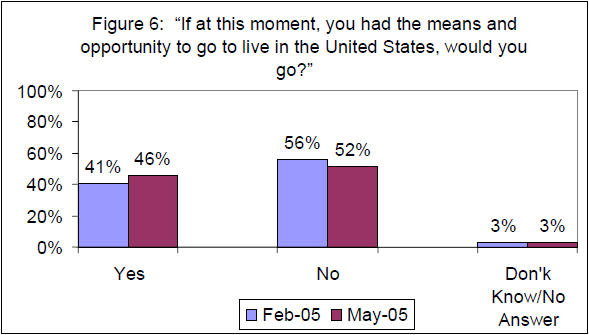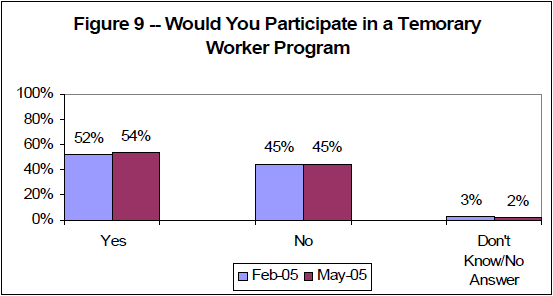More migrants come to the United States from Mexico than from any other country, and Mexicans comprise 30% of the total foreign born population and 58% of the Latino foreign born. In order to explore views among Mexicans who are not now migrants, the Center has been conducting a series of monthly surveys in Mexico on topics related to migration since the beginning of 2005. This is the first report on those surveys. The data for each survey was collected through household interviews of adults conducted in 120 locations across the country. The interview sites were chosen through a well-established process designed to produce a nationally representative sample. A sample of 1,200 people was interviewed for each of the two surveys cited here, and the results for the total population have a margin of error of plus or minus 3%. All of the fieldwork was conducted by Consulta Mitofsky, a public opinion polling and social science research firm headquartered in Aguascalientes and Mexico City, as part of its monthly omnibus survey of the Mexican population, the Ómnibus Mensual ABC. Findings are presented here from two surveys. The first was conducted from February 11 to 19, 2005 and the second was conducted from May 13 to 17, 2005. The same questions were asked on each survey, and both were conducted with the same methodology. But, they are two separate polls with entirely different samples.
The Inclination to Migrate
[Si en estos momentos usted tuviera la manera y la oportunidad de irse a vivir a los Estados Unidos, ¿usted se iría?]


An estimated 10 million adult Mexicans now live in the United States and somewhat more than half lack authorization. In other words, about one of every eight adults born in Mexico now lives in the United States. In the PHC surveys, 46% of Mexican adults in February and 37% in May said they have a relative living or working in the United States. Those Mexicans who have already migrated serve as a draw for future migration. Respondents with family members here were more likely to say they would migrate if they could (52% in February and 54% in May) than those who do not have relatives in the United States (33% and 40%).
The willingness to migrate is higher among men than women and among the young than the old. This sentiment is distributed almost evenly across income ranges, and significant shares of well-educated Mexicans and those who live well beyond poverty also say they would come here if they could (See Table 8). These findings suggest that simple economic or social status alone is not the primary determinant of whether an individual is willing to consider migration. Rather, this survey data reinforces a substantial body of research literature which shows that the decision to migrate is influenced by the workings of family networks, perceptions of relative economic opportunity and other factors aside from socio-economic status.
Differences in the willingness to migrate according to respondents’ levels of education suggest the effects of economic expectations as opposed to absolute poverty. Mexicans with the lowest levels of education—primary school or less—are not necessarily the most likely to migrate. As a result of improvements in Mexico’s public education system in recent decades, adults who never got beyond a primary education are now concentrated among the middle aged and the elderly. Migration is most typically an activity of young adults who in Mexico are better educated than their elders on average. As a result, the educational profile of Mexican migrants to the United States has been improving over the past 40 years or so.

The survey data suggest that Mexico’s improvements in education have not stemmed the inclination to migrate so much as shifted up from those with barely a primary education—typical in the mid-20th century—to persons with some secondary education and even the college educated. The disposition to migrate is highest among those who have completed secundaria, a lower form of secondary education that often focuses on vocational training and does not qualify a student for bachelor’s-level college studies. The next highest educational category in willingness to migrate is Mexicans who completed preparatoria, which is the equivalent of a U.S. college-prep high school education. These individuals have benefited from improvements in the Mexican educational system, but their willingness to migrate in large numbers suggests that they have not yet benefited from an expansion of economic opportunities commensurate to their skills.
The PHC Mexico Surveys also show that the willingness to migrate is widely felt in the most accomplished sectors of Mexican society. For example, 35% of those with at least a college education and 45% of those earning at least seven times the minimum wage said they were prepared to migrate. The same holds true when Mexicans are asked whether they are inclined to migrate illegally. More than one-eighth (13%) of those with at least a college degree and more than a fifth (22%) of those earning at least seven times the minimum wage said they would come without authorization.
Temporary Worker Programs
[Pensando en sus parientes y amigos, ¿ cree usted que les interesaría irse legalmente a trabajar en los Estados Unidos mediante un programa de trabajo temporal a condición de regresar al cabo de algunos años?]






